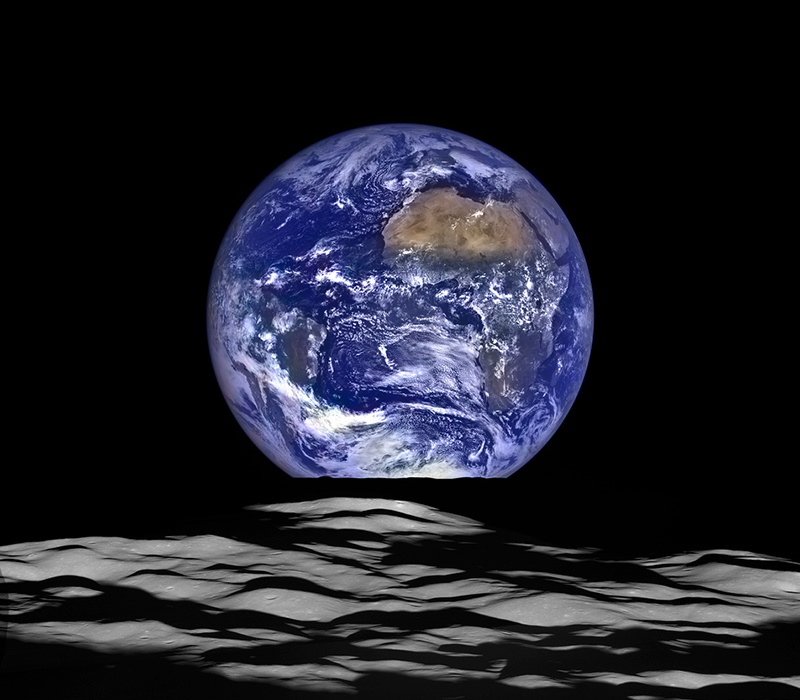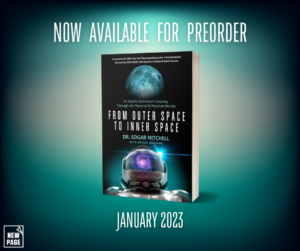From Outer Space to Inner Space traces two remarkable journeys―one through space and one through the mind. Together they fundamentally alter the way we understand the miracle and mystery of being, and ultimately reveal humankind’s role in its own destiny.
Previously published as The Way of the Explorer, this edition includes a new foreword by Avi Loeb, New York Times bestselling author of Extraterrestrial, an afterword by Dean Radin, Chief Scientist at IONS, and a postscript chapter by the author, IONS Founder Dr. Edgar Mitchell (1930-2016).
Here is an excerpt from the book, publishing on January 1, 2023.
When I founded the Institute of Noetic Sciences in 1972 to pursue these studies, I accepted the struggles and triumphs, the encouragement of faithful friends, and the disparagement of detractors as a part of a larger process. Daily life itself, I came to recognize, was the only vehicle for learning, as each life expresses one of nature’s emergent potentials that may prove significant for the whole. And it was in this way that I came to trust the process as synchronicities occurred time and again to destroy a meticulously constructed plan and replace it with a bold new direction not previously apparent. Intuitive feeling soon came to be a trusted friend, with rational thought and planning used to fill in the details.
Notions of cosmic accident and omnipotent design were set aside as questionable sources for these surprising synchronous events. Our capacity to survive and to accumulate knowledge in this fashion, and exercise volition, would not be possible unless the seeds for their existence were somehow rooted in the fundamental structure of the universe. Other universes may have come and gone, expanded and collapsed, tried and failed, because they had characteristics different from ours. But we’ll likely never know.
Our own universe has survived long enough to produce sentient beings who seem to possess volition and can learn. And volition, however limited, is sufficient to eliminate determinism in its strictest sense. As late as the early 1900s there was no way to credibly falsify the materialist argument that volition is an illusion and that we are merely inhabitants of a universe grinding mechanistically and inexorably toward our predetermined end—and not under remote supernatural supervision. There was no way to convincingly argue that life was not a film strip in which the next frame would reveal the consequences of the prior frame’s choice. Quantum mechanics opened the door for choice among the possibilities permitted by the laws of physics, before it stumbled against the entrenched Cartesian barrier of mind.
Existence requires matter and energy, and knowing requires information. All of these components of physicality were present from the first moments of galactic creation. Not until I realized that volition requires perception, and I’d made the assumption that it was omnipresent in some form, did the dyadic model begin to look truly interesting. Knowing and learning must have evolved right along with physical structure. As I worked through the various issues, paradox dissolved and descriptions of reality simplified. All I had to do was take proper care in understanding the interaction between what exists and how we know—a study in epistemology. By 1987 the model seemed solidly in place in my own mind, and I was startled by how it seemed to depict the universe we experience.
I didn’t start out with the idea of dyads in mind, but along the way the presence of dualisms kept appearing: wave/particle, positive/negative charge, mind/matter, body/spirit, religion/science, male/female, yin/ yang, and what have you. The dualisms all related either to existence, knowing, or both—all of which are complementary and/or opposites.
This seemed to me rather fundamental. Dualisms that cannot be separated are better described as dyads, the opposite faces of the same coin. Dualisms result when an observer gets stuck observing one face or the other and does not transcend to a broader viewpoint.
Then something else occurred to me, the paradox of all paradoxes: Determinism and volition result from dyadic considerations as well. Volition is an attribute of existence; determinism a product of knowing. Volition is required for creativity and change, and determinism is a result of discovering stability and continuity in nature, and then becoming fixated on stable, continuous processes. Creativity and stability must exist side by side in our universe, as they too are a dyadic pair. Unlimited creativity would be totally chaotic, but strict determinism would void innovation, the cornerstone of evolution. Science is not destroyed by the presence of volition in the universe, just as mysticism is not destroyed by the presence of science. Both are just faces of knowing.
But there was something distressing about the results of a dyadic, evolving learning model for the universe: In such a place there are no immutable guideposts for fallible humans to follow, no submerged absolute laws. Only trial and error and learning based upon experience.
However, the pre-sentience universe has had several billion years of experience to its credit, and has learned successful behaviors in that time. Both science and religion codify them as laws. Civility, kindness, and love arose as choices to offset brutality, violence, and powerlessness in our more primitive social milieu. The inanimate universe is violent and explosive on all scales, and the early animate world only slightly less brutal, where only the fittest survived. Our earliest gods were angry, violent, and capricious, because that was the way the world appeared to our ancestors. Much later, we invested our gods with wisdom, love, and caring, because that was the essence of the world we wanted to live in; that was what we wanted our world to become. So arises an important point: we will ultimately become, both individually and as a civilization, the essence of our deepest intent.
Read more in this early look at From Outer Space to Inner Space. Buy it here and where books are sold.
Adapted, and reprinted with permission from New Page Books, From Outer Space to Inner Space by Edgar Mitchell is available wherever books and ebooks are sold or directly from the publisher at www.redwheelweiser.com or 800-423-7087.

